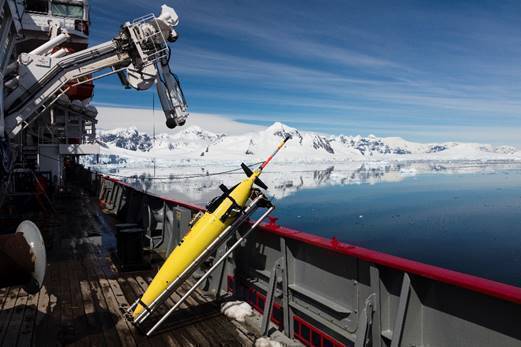UCT scientists part of international study of Antarctic waters - the least studied place on the planet


University of Cape Town scientists from the Department of Oceanography, Dr Marcel du Plessis and Isabelle Giddy, are both part of an international study that is attempting to occupy and collect vital measurements from the least studied place on the planet – the frigid ice-covered waters of Antarctica.
During winter, Antarctic sea ice expands – as an extension of the continent – over an area of the sea large enough to cover the size of South Africa 14 times. Almost all this sea ice melts away during summer, leaving a layer of fresh water on the surface of the ocean thousands of kilometres wide but only a few tens of metres deep. The fresh water is very light compared to seawater, which prevents them from mixing vertically. This changes the ocean’s ability to take up heat from the atmosphere.
This study will provide key observations to help researchers understand how the sea ice meltwater in Antarctica grows laterally and deteriorates, thereby altering heat uptake by the ocean and impacting the climate.
Growth and melt of sea ice happens in response to ocean temperatures, and so – as we move towards a warmer climate – the ocean will absorb more heat. This will change the growth-and-melt behaviour of sea ice. The waters off Antarctica are the most difficult to measure through observation. The vastness and remoteness of the Antarctic and its rapid ice growth and drift mean that the long-term observations needed cannot be obtained from ships, which only go down to Antarctica for a few weeks a year.
Instead, autonomous underwater vehicles, called gliders, which are self-sufficient and provide researchers with a profile of the ocean every few hours will be used.

Seagliders are battery-operated, self-sufficient and can send researchers a profile of the ocean every few hours. Photo credit: Emma Bone.

Autonomous underwater vehicles like this one will roam the waters of Antarctica for two years collecting information about the ocean there. Photo credit: Louise Biddle.
The measurements collected by the gliders will inform researchers from the UCT Department of Oceanography, as well as their international partners, how the ocean will react to and influence a changing climate.
The primary gliders being used are Seagliders. Designed to be small – about 1.5 metres long – and operated on battery power, they can sample the ocean for many months without human intervention. Their bullet-shaped design helps them fly through the ocean. Seagliders can profile the water column at different depths by changing their buoyancy to become heavier or lighter than seawater. They rise to the surface every six hours and ‘call’ the researchers via satellite communications, allowing them to access their dive information and scientific data in real-time.
This study will also provide unprecedented data to see the impact of the hurricane-force winds that sweep through a wind belt in the southern hemisphere called the Screaming Sixties. These are the strongest winds in the world. They act in a similar way to a blender at the ocean surface by mixing fresh, surface water with the saltier water below. Researchers are also trying to find out how these storms drive the mixing of heat from the surface down into the water column.
The project, named ROAM-MIZ (Robotic Observations and Modelling of the Marginal Ice Zone), is co-led by Associate Professor Sebastiaan Swart at the University of Gothenburg and Dr Sarah Nicholson of the Southern Ocean Carbon and Climate Observatory, which is supported by the South African National Antarctic Programme. Swart and Nicholson both obtained their PhDs from UCT. Other collaborators come from the United States, the United Kingdom and Norway.
To track the latest data and locations of the gliders visit the ROAM-MIZ website.